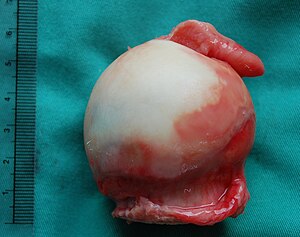Femoral head grossing
Jump to navigation
Jump to search
This article covers femoral head grossing. Femoral heads are relatively common specimens.
Femoral heads, in general, are covered in the article femoral head.
Introduction
Common diagnoses:
- Osteoarthritis - usually in older individuals, may occur in younger individuals in the setting of previous trauma.
- Fracture - usually secondary to osteoporosis - in older individuals.
Less common diagnoses:
- Pathologic fracture, i.e. fracture due to malignant neoplasm.
- Avascular necrosis - usually in younger individuals, classically associated with steroid use.
Protocol
Specimen: femoral head.
- Laterality: [left/right].
- Dimensions:
- Head (along axis of neck x depth x width): ___ x ___ x ___ cm.
- Neck (length x depth x width): ___ x ___ x ___ cm.
- Cartilage thickness: ___ to ___ cm.
- Shape of head: [round/irregular].
- Neck resection margin: [cut/irregular].
- Articular surface: [smooth/irregular/separated from underlying bone/eburnated].
- Other findings: [none/osteophytes/synovial hyperplasia].
- Cut surface findings: [none/subchondral cysts/subchondral sclerosis/osteophytes].
- Other tissue: [none/joint capsule and surround tissue - measuring ___ x ___ x ___ cm].
Representative section(s) submitted from:
- Articular surface and underlying bone.
- Scrappings from the resection margin (if no fracture).
- Scrappings from the fracture site.
- Surrounding tissue.
Protocol notes
Alternate approaches
See also
Related protocols
References
- ↑ URL: http://www.path.utah.edu/casepath/ms%20cases/ms%20case%205%20comp/case%205.htm. Accessed on: 11 October 2012.
